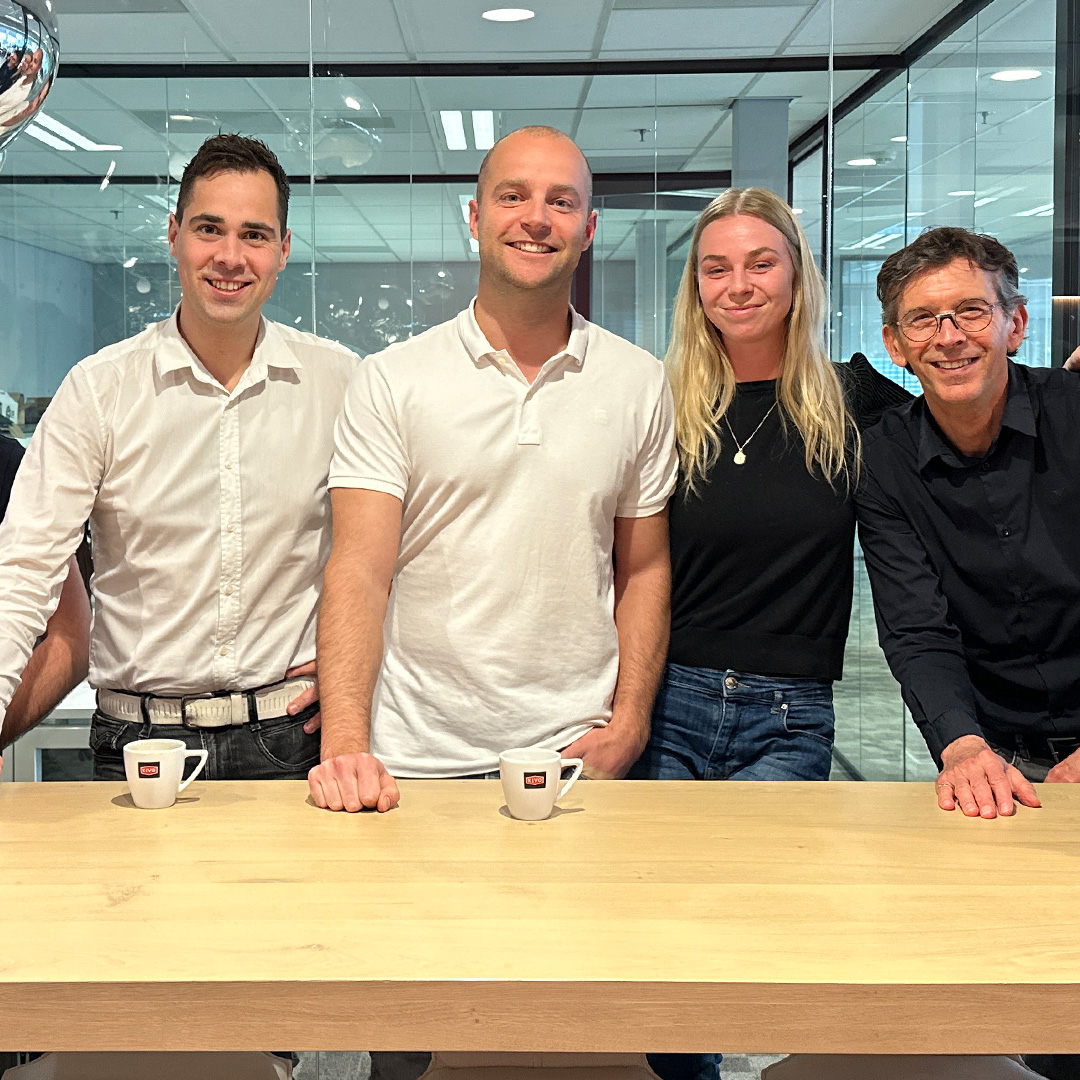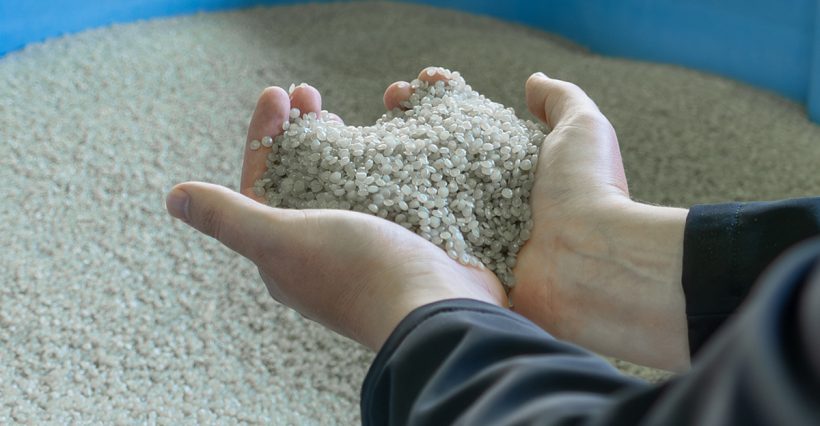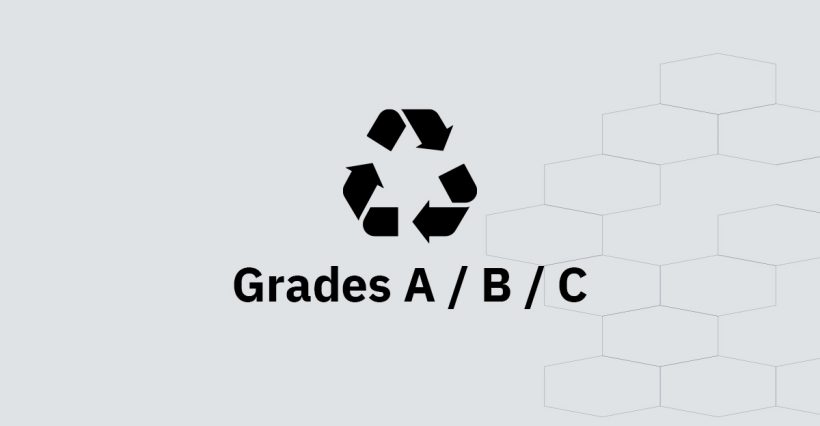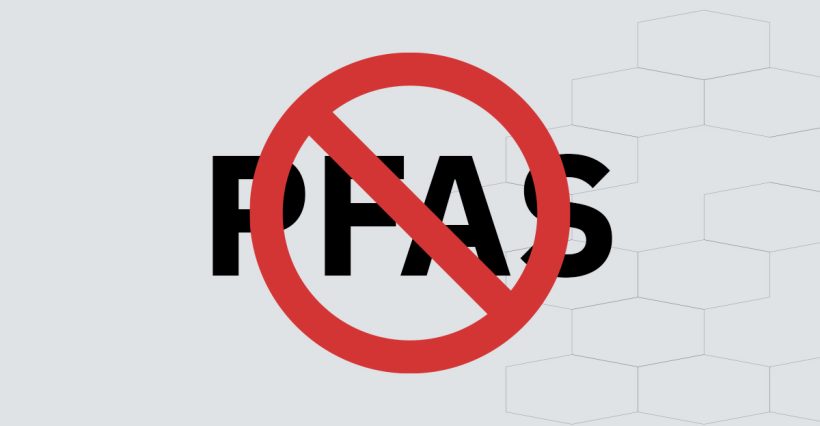film, as referred to in this article, refers to flexible plastic packaging material. Formally, a packaging material is considered flexible when it has a thickness of up to 250 microns. The choice of material depends mainly on the application, the customer's specific requirements and sometimes the manufacturer's production capabilities. Years of further optimisation of packaging have meant that there are now endless variations. That variation makes recycling a challenge in itself, and we understand that uncertainty arises among our customers around whether the material they use as packaging is recyclable or not.
In theory, almost all types of plastic can be recycled separately. Nevertheless, we try to distinguish between roughly 2 types:
- films which are technically moderately to well mechanically recyclable and;
- films which are technically very limited or not mechanically recyclable.
(Read all about it here Mechanical recycling).
However, the recyclability of the material itself is not the only condition that determines whether a film will eventually be recycled. This is because there are a number of other factors that can still make recycling difficult. These include degree of contamination, size of the material, type and degree of printing, presence of additives (colouring, calcium, flame retardant, etc.), presence of stickers, tape and labels, etc. A final important condition is that the recycling infrastructure must be tailored to the specific material. If it is ultimately not separated from a larger mix of materials, because the right technology is not present, the recycling process is too expensive or complicated, or there is simply no market for it, it is still likely to be incinerated or landfilled.
films which are moderately to well mechanically recyclable
These are mainly films with a simple structure (the mono-materials) and then especially the films which are made of plastics belonging to the polyolefins group, such as Polyethylene in different densities (LLDPE, LDPE, MDPE and HDPE) and Polypropylene (although PP is slightly less optimally recyclable than PE).
films which are very limited or not mechanically recyclable
Mono-materials consisting of other types of plastics such as PET, PS, PVC or PA are currently not being recycled very successfully. The same applies to multilayer packaging consisting of different materials that are laminated together, for instance, or where material is vapour deposited (so-called multi-materials). Think, for instance, of crisp bags often consisting of PP with aluminium, or bake-off sandwiches packaged in a combination of flexible tray with cover film where the materials PET, PE, PVdC, PA and EVOH are all used together in that one packaging. Because the packaging does not consist of purely 1 type of material, it is already difficult for sorting equipment (or for sorting staff) to separate the packages properly in the first place. Next, the materials used in the packaging would have to be physically separated from each other. Indeed, the materials do not mix/mix well with each other, so the recyclate will be of poor quality. However, separating materials attached to each other is too complicated and/or not economically viable.
Of course, technological developments may eventually allow more material types to be better recycled. If you do want to design more circular packaging now (design for recycling), the advice is to give preference to Polythene when choosing materials. However, always take into account the environmental impact over the total life cycle. For example, if PE sacrifices too much on shelf life or content protection, then more circular is not necessarily more sustainable.
Factors that determine whether a film can be successfully recycled
Unfortunately, if you now have packaging made entirely (or mostly) of PE, it does not mean that it is obviously highly recyclable.
The KIDV's recycling check flexible packaging distinguishes between good recyclable, reasonably recyclable, limited recyclable and not desirable or not recyclable. The decision tree looks at collection, interfering materials, barriers during sorting and barriers during recycling. What is still missing in the recycling check, but is relevant in practice, is the type of contamination and the degree of contamination.
In a nutshell, packaging as waste only good is recyclable if it is pure PE packaging larger than A4 size and free of all kinds of impurities, such as labels, non-washable adhesives, additives (such as barriers, coatings and fillers) and metal parts. In principle, therefore, any additives pose a potential additional barrier to recycling. In practice, there is almost always one or more additives. The most common additives such as labels and stickers are often applied only later in the supply chain (e.g. in the DC or in the shop). This quickly makes packaging less recyclable, or it quickly makes the end result (the recyclate) of lower quality.
- Collection and disturbances
According to the recycling check, nets (e.g. for oranges and onions), medicine packaging and packaging belonging to small chemical waste belong to residual waste and will therefore not be recycled as plastic. Furthermore, the material must first of all be free of interfering substances such as Oxo-degradable material, PVC, elastomers, silicones and non-plastic material layers to be recycled.
- Barriers during sorting and recycling
The steps in the mechanical recycling process of flexible packaging usually consist of sorting (automatic or manual), grinding/shredding, washing, separating, drying, melting, granulating (granulating) and cooling and drying again.
In particular, the size of the waste is an important factor during the sorting process. The smaller the waste, the more difficult it is to recognise and separate during sorting, which is why it is called A4 size.
Additions in the film can worsen recyclability for several reasons. For instance, black dye cannot be recognised in some sorting facilities, so it quickly ends up in the mixed fraction. Adding Calcium Carbonate (a commonly used filler), for example, has the additional effect of increasing the specific gravity of the material. PE is usually lighter than water, so through a common float-sink separation process, any heavier materials (such as PA and PVC) are removed from the main stream. If the PE has also become heavier than water through significant addition of calcium carbonate (or other additive), the material will still be removed from the main stream and end up in the residual fraction. Other additives (such as EVOH or flame retardant) can have a negative effect on the quality of the recyclate, or the extrusion process, if the content is too high (> 5% is now often used as a rule of thumb).
Traces of (paper) labels, stickers and glue residues often remain during the recycling process and have a negative effect on the quality of the recyclate, the recycling process and/or the extrusion process. (Read more about extrude).
Metal parts, such as staples, can cause metal detection during the sorting process to cause the entire packaging to end up in the mixed fraction already. If metal parts do find their way into the further process steps, they will cause problems there too. Think of wear and blocking of knives, screws and filters and downtime of the line due to metal detection,
- Pollution
Although much of the plastic waste can be properly cleaned by cold or hot washing, in practice not all waste will be accepted and, regardless of the material, it still often finds its way to the incinerator. Think of:
- difficult to wash oily food residues such as oil, mayonnaise and butter.
- Food leftovers that carry the risk of bacterial growth, fermentation and attracting pests are also undesirable.
- films without excessive food residues but to which a strong odour is attached (such as fish packaging) will not be accepted by many processors.
- Also, if there is still a lot of non-food-related material residue on or in the packaging, such as cement, lime, sand/earth/branches/twigs, this will quickly lead to problems during and after recycling.
Besides the nature of contamination, the degree of contamination already causes waste to lose its value. After all, processors often pay for the weight of the waste. More contamination therefore means less revenue and more issues to get rid of the resulting waste streams.
Why does mechanical recycling matter?
The main added value can be summarised as follows:
- It helps prevent littering
- By repurposing materials, we need to extract fewer fossil resources from the earth.
- Mechanical recycling also generally has a lower environmental impact than producing new polymers, or the alternative process of chemical recycling.
- After mechanical recycling, the materials can still eventually be chemically recycled or used as fuel for energy recovery. This way, you really get the most out of the material.
There are important caveats, though:
For instance, recycling is not necessarily synonymous with fully circular. After all, flexible (food) packaging cannot be used in similar food packaging after recycling. This is mainly to do with food safety, but the mechanical properties of the recycled material also often have their limitations. Also, packaging that is coloured, or printed will for the most part only be recycled as "variegated" pellets. Their uses are thus more limited. This is also known as downcycling. The challenge is to reduce downcycling as much as possible. This is only possible if waste streams are kept as pure, clean and separated as possible. Setting up closed loops can contribute to this
The challenges and opportunities differ by channel and region. What applies to household waste may not necessarily apply to commercial waste, and the collection structure and recycling technology available may differ by country (or even by region/municipality). Packaging waste released from businesses (often secondary and/or non-food-related packaging), such as retail, logistics service providers and manufacturing companies, is often contaminated to a lesser extent, and since there is usually value in that waste, the streams are often already reasonably to well separated at source. The recycling rate is significantly better than the average statistics show for those streams, which anyway comprise easily a third of total plastic packaging waste. Within those streams, the challenges are often smaller and the opportunities greater. For packaging that often ends up as household waste (or PMD), it is therefore more complex to determine what changes can be effective. In addition to bringing in a packaging expert, it can therefore help to consult household waste recycling companies such as Attero, or GP Groot, or even contact the scientists at Wageningen University & Research with their extensive knowledge of material flows.
There are continuous technological developments (such as de-inking, deodorisation, finer sorting, etc.) and sales markets are constantly changing. Thus, recycling opportunities are also constantly evolving. Thus, certain insights in this report may also be outdated in the short term.
Design for recycling (designing packaging that can be optimally recycled) should not be an end in itself. If, by converting from laminate to pure PE, you have to sacrifice too much on shelf life or protection of the product, you will have to investigate whether the switch will bring environmental gains at the bottom line.
Design for recycling is not the same as deployment of recyclate. If much more packaging can be recycled, but the market for recyclate lags behind, de facto recycling will still be limited. In food applications, the use of recyclate is difficult, but there are still numerous applications in which much more recyclate could be processed. This requires attention from processors and packaging industry on the one hand, but the right economic incentive is also necessary. As long as primary raw materials can compete strongly with secondary raw materials on price, the use of secondary raw materials will lag behind.
Replacing laminates with recyclable ones film
For a large number of packaging applications, we see that the laminate can be perfectly replaced by a non-laminated PE variant with excellent recyclability. One example is frozen food packaging for vegetables, fruit and chips, for example. Our special (FFS film) PE-film with extra rigidity can provide the desired rigidity of the packaging, without having to compromise on the protection and shelf life of the product. Meanwhile, we can use this film also be supplied in a variant that can be processed on heat-seal systems without problems and modifications.
Wondering what role KIVO can play in making your plastic packaging more sustainable?
If so, please contact our Product Specialist Mike Bakker using the contact details below.
Mail: mbakker@kivo.nl
Tel: 0610621323
You can also fill in the contact form below! You will then receive a response as soon as possible.



